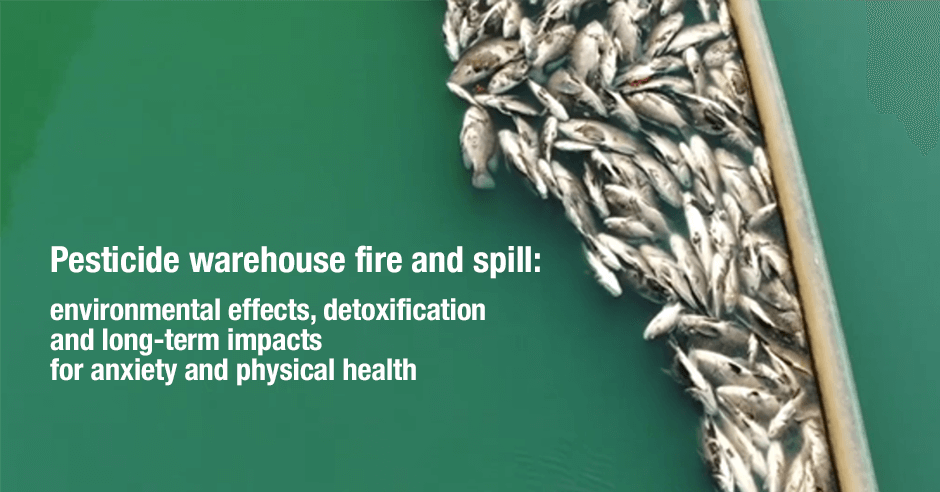
One month ago, during the political riots in South Africa, a warehouse in Cornubia was burned down causing a slew of pesticides, insecticides and fungicides to be spilled into the nearby river and ocean, and burned into the atmosphere. This happened in a semi-industrial area bordering on residential areas such as Umhlanga Rocks and Sunningdale, and the informal settlement Blackburn. My sister and her family live in Umhlanga Rocks and we frantically communicated (during the riots and after the spill), trying to figure out what was going on, with me offering insights on how to help them mitigate some of the short-term toxic health effects. These included practical steps to avoid the toxic air and water, and some nutritional approaches to start supporting detoxification.
While this blog is specific to the situation in South Africa, something like this could happen near you one day. For this reason, I’m sharing what I have learned and what I already know about environmental toxins so you are aware of the short-term and long-term impacts for anxiety, mood and physical health.
Much of the nutritional support and detoxification recommendations are also applicable if you are dealing with smoke from forest fires too, like much of the western states of the US and Canada right now, and some countries like France and Greece in the EU.
The South African civil unrest and riots that led to the pesticide fire and spill
This article describes the civil unrest and explains how “South Africa suffered an insurrection attempt with two provinces, KwaZulu-Natal and Gauteng disabled, and national fuel and food supply lines disrupted.” It is thought that twelve masterminds planned and executed it on social media and then lost control after the looting started.
The pesticide warehouse in Cornubia, KwaZulu-Natal, was leased by United Phosphorus Limited (UPL) and was burned down as a direct result of this rioting and looting.
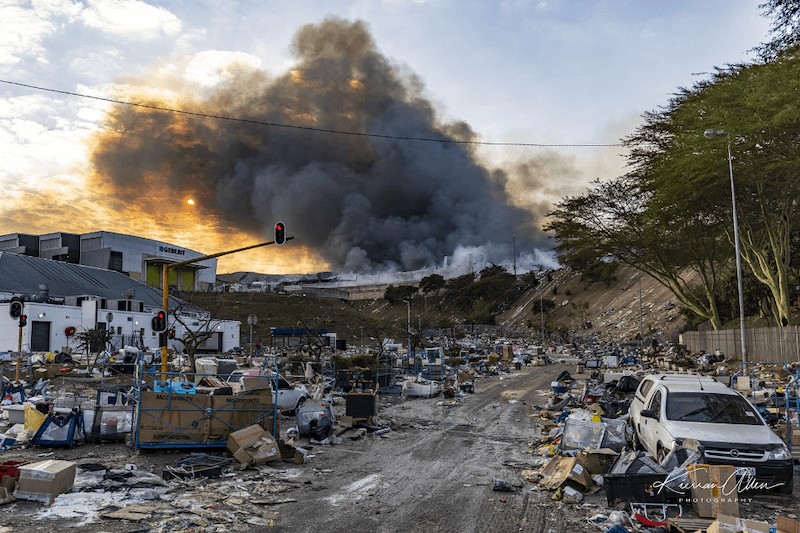
The Cornubia warehouse was one of many hundreds of factories, stores and warehouses that were burned down, all contributing to a toxic soup in the atmosphere.
Wildlife photographer, Kierran Allen, captures the above scene and many other shocking images. Check them out on his Facebook page and here.
The pesticide warehouse fire and spill
The UPL product list is long and includes 124 herbicides, 43 fungicides, 52 insecticides and various other chemicals. I looked through some of the categories and found atrazine, paraquat, glyphosate, chlorpyrifos and many more.
As of today, 30 days after the initial fire, the company has not disclosed which products were part of the fire and spill (more on this below).
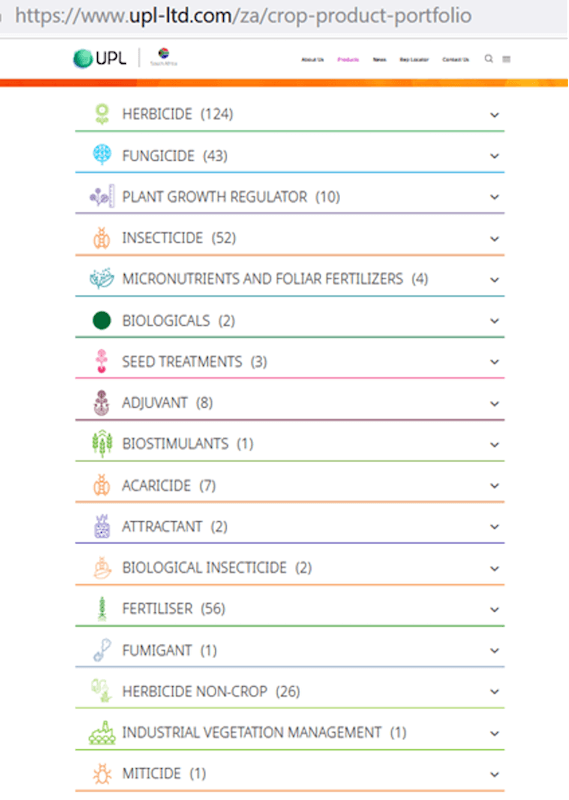
As a result of the warehouse fire and spill, the Ohlanga river and Umhlanga lagoon turned a strange green-blue and thousands and thousands of fish were killed. The beaches and sea water became toxic too. Koi fish in a nearby neighborhood pond died. Surfers reported burning skin while surfing at Umdloti, 12 km north of the lagoon mouth.
Individuals in the community reported headaches, burning skin and eyes, asthma, nose and throat problems, and coughing. I also saw a report of “oily black goop floating on my pool surface” and getting on the paws of their cats and dogs.
Drone Fundi published an excellent 3-minute aerial video on their Facebook page and gave me permission to snag a screenshot of the dead fish image for this blog.
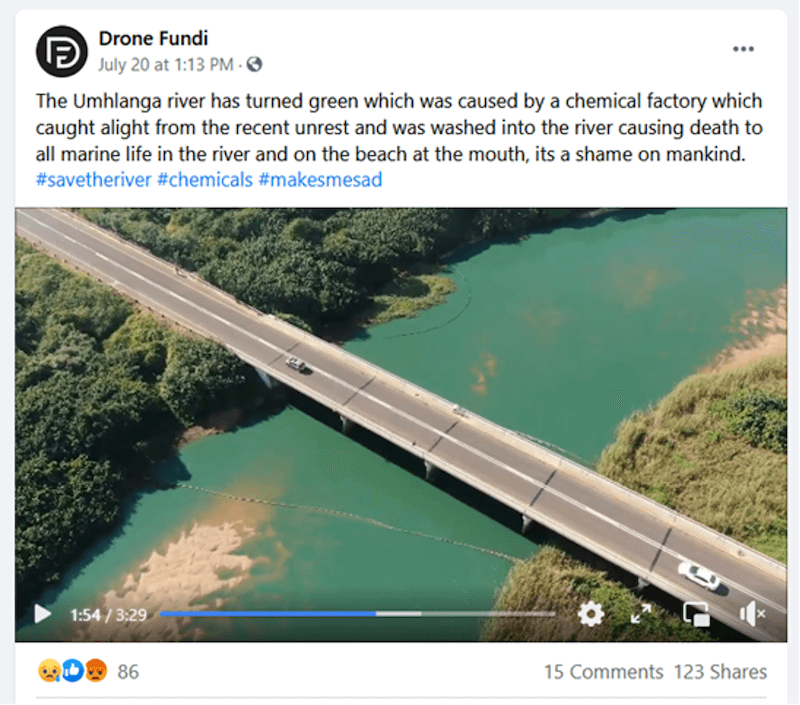

Excellent coverage by environmental journalist, Tony Carnie
Environmental journalist, Tony Carnie, has provided the most comprehensive coverage in a number of excellent articles on The Daily Maverick blog:
- On July 20th, 2021: New health warnings issued in Durban over toxic fumes stemming from chemical blaze
The Indian multinational pesticide company United Phosphorus Limited has belatedly advised people to double down on health and safety precautions in the wake of the arson attack and massive fire at a chemicals warehouse at Cornubia, north of Durban.
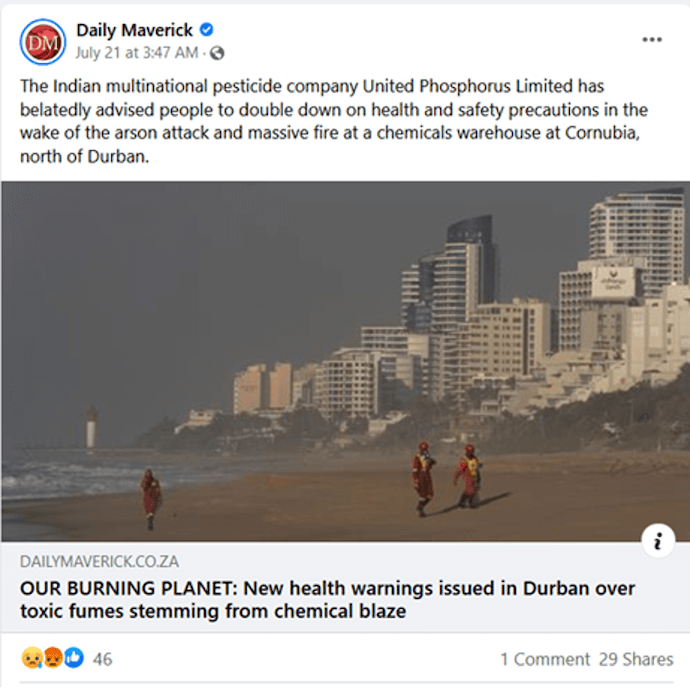
- On August 12, 2021: ‘Lift the cloud of secrecy over Durban toxic chemicals explosion,’ MPs and community leaders demand
It has been exactly a month since a massive cloud of toxic chemical fumes engulfed residential areas over large parts of Durban for 12 days – but government officials and the Indian-owned UPL agrochemicals giant are still refusing to release a full inventory of the quantity and type of poisons to the public.
Red flags about the fire and spill that concern me
As I read the media articles, the company press releases and reached out to the company, a number of concerning red flags started showing up:
- UPL hired a risk management company to do the press releases and respond to enquiries. I did correspond with them and although very responsive they didn’t initially provide details of what pesticides were involved and then offered a partial list
- The first press release on July 17, 2021 mentioned a warehouse storing “plant protection products.” I had never heard this term before and had to look it up – they are pesticides and other chemicals like insecticides and fungicides. It took a good few days for this to make it into media reports
- UPL consulted with Dr. Gerhard Verdoorn and shared this in a press releases on July 19, 2021:
He was provided with a list of the crop solution products stored in the warehouse, and was requested to provide guidance on the possible health implications posed by the release of these products into the environment.
In his view, there is a minimal risk of any long-term effects to the health of people exposed to smoke from the warehouse. However, exposure in the short term to some of the chemicals contained in the crop solution products may result in dermal, eye and respiratory irritation.
This does not mention that Dr. Verdoorn is an industry spokesperson and I have concerns that they continue to downplay the severity and possible long-term impacts.
This same press release did mention some of the chemicals that were in the fire:
Some of the herbicides, such as chloroacetamides (for example, acetochlor, S-metalochlor), phenoxycarboxylic acids (2,4-D, MCPA and benzoic acids, or dicamba) may not have burned out completely. Two pyrethroids – alpha-cypermethrin and lambda-cyhalothrin – which are dermal, eye and respiratory tract irritants may have been present in the smoke.
- One of my first thoughts was why is this warehouse located so close to residential areas and why don’t they have safety measures in place
- 30 days later there is no disclosure of what pesticides and how much (The Daily Maverick blog reports this). One article mentioned they don’t want to provoke anxiety in the community by sharing the list. Not knowing causes anxiety and concerns.
- 30 days later there is no expert commentary on long term potential impacts (I share more on this below) and long term mitigation/cleanup and detoxification approaches for the community
After watching movies like Erin Brockovich, Dark Waters (the true story of Dupont and Teflon) and Rainmaker, red flags like this need to be documented. I’m more than happy to take all this back if and when things change.
I share all this for the residents of this area who are being impacted right now, and so you can get an idea of red flags to look out for if you encounter something like this in your neighborhood one day.
Update August 17th: The list of chemicals
According to this Daily Maverick article, Here it is: The toxic stockpile of chemicals in torched United Phosphorus Limited Durban warehouse
*More than 26 000 kilograms of Masta 900, an insecticide containing the “very potent neurotoxin” methomyl for which “contact with skin, inhalation of dust or spray, or swallowing may be fatal.”
*Another 1 800 litres of methamidophos, also a “very potent neurotoxin”.
*More than 40 000 litres of products using the herbicide paraquat which poses “high risk for all life forms”.
*Over 19 000 kilograms of Terbufos, another “very toxic” chemical presenting “high risk to all forms of life”.
*More than 600 000 kilograms of products containing tebuthiuron, a chemical classified as “very toxic to aquatic life … with long lasting effects” sold under a variety of brand names including Lava 800 and Limpopo SC.
*More than 160 000 kilograms of potassium hydroxide and 100 000 kilograms of ammonia hydroxide, both intermediate products used in manufacturing that are “extremely caustic” chemicals that burn skin on contact.
*More than 3 000 kilograms of Cyprex, a “highly active herbicide” containing halosulfuron-methyl, a product that “may damage the unborn child”, according to the European Chemicals Agency.
*More than 500 000 litres of Triclon, a product containing triclopyr butotyl and classified as “flammable, harmful and environmentally hazardous” and that “may cause lung damage if swallowed”.
*More than 30 000 litres of MSMA 720, also known as monosodium methylarsonate which has been shown to have “limited evidence of a carcinogenic effect”, and over time converts to inorganic arsenic in soil with the potential to contaminate water sources.
*More than 30 000 kilograms of oxamyl-based insecticides, including products Bandito and Oxadate, that also present “high risk for all life forms”.
*Almost 11 000 kilograms of Tenazole, containing “extremely flammable” fungicide terbuconazole.
*More than 1 000 litres of Colloso, a fungicide containing the active ingredient carbendazim which “may cause heritable genetic damage”, “may impair fertility”, and “may cause harm to unborn child”.
Practical solutions for short-term immediate exposure
As soon as I learned what had happened I started reading everything in the local media, contacted UPL, looked up the products they carry and immediately shared Dr. Elisa Song’s 2018 blog with my sister and friends: How to Detoxify When Air Pollution is High. Dr. Song published this resource for keeping children and families safe and healthy through the tragedy of the 2018 California fire season.
I knew her advice on “Optimizing Indoor Air Quality” would be perfect for the toxic pesticide situation too:
- keep doors and windows closed at all times
- have separate outdoor clothes and shoes
- vacuum daily and use a HEPA filter
- bring plants inside to help improve air quality
- use your air conditioner as another way to clean the air and
- diffuse essential oils.
My additions were as follows:
- don’t hang clothes on the washing line
- keep your pets inside and wipe them down after they go outside
- ideally go somewhere away from the situation
- definitely don’t go to the source to see what is happening as exposure will likely be much higher.
I also reached out to colleagues for specific information relating to a pesticide spill and certified Toxicity and Detox Specialist, Sinclair Kennally, very kindly did a write up specially for this situation. In her blog post, Environmental Toxin Exposure: what to do when disasters hit, she shares wonderful advice on:
- daily best practices during the disaster
- DIY strategies to reduce toxic exposure when supplies are scarce
- herbs that can be used for first aid in a pinch
- most important supplements for recovery afterwards
- using activated charcoal or zeolite on laundry loads
- making your own air filter pet care (using apple cider vinegar and bentonite clay/activated charcoal)
- emergency essentials (especially water).
Detoxification solutions, and respiratory and immune health
Dr. Song’s detox advice on the same blog on “Supporting Respiratory and Immune Health” is very applicable for a pesticide spill such as this and for forest fires (and other environmental pollution): “Daily epsom salt baths to support detoxification and enhance magnesium and glutathione levels,” liposomal glutathione, extra magnesium and essential oils to support detoxification, immune and respiratory health. She mentions citrus and lavender essential oils which offer the added benefit of being calming and helping with sleep too (more on that below).
On Sinclair’s blog she empahsizes “Toxin excretion is the most crucial stage of any disaster” and she discusses sauna, binders, mobilizers and support for detox pathways in great detail.
The stores were all closed because of the looting so I gathered some additional resources in case folks didn’t have certain things on hand:
- N-Acetyl Cysteine/NAC – improves glutathione levels, is a powerful antioxidant, “acts directly as a scavenger of free radicals” and is a mucolytic (clears mucus and relieves breathing difficulties)
- Rooibos tea – is neuroprotective and it’s “cell-protective activity …is connected with the ability of reducing glycaemia, inflammation as well as oxidative stress.” It also eases anxiety and supports healthy cortisol levels
- Apple cider vinegar (preferably organic with the mother) – “could be promising for attenuation of liver cell damages induced by several toxins through its powerful antioxidant properties” due to its major constituents of flavonoids and polyphenols.
- Broccoli sprouts or extract – “the sulforaphane may be exerting its protective actions by activating a signaling molecule, NRF2, that elevates the capacity of cells to adapt to and survive a broad range of environmental toxins.” The authors go on to say it’s a “frugal, simple and safe means that can be taken by individuals to possibly reduce some of the long-term health risks associated with air pollution.” A simple way to get some of these benefits is to make your own homemade broccoli sprouts (easy and lots of fun to nurture them and watch them grow!) and to consume them daily!
- Vitamin D3 – “vitamin D is a significant factor in detoxification and protection against environmental toxins” (used based on vitamin D levels i.e. always test first)
Sleep, stress/anxiety, pyroluria and immunity
Sinclair starts with a reminder to “be gentle and kind with yourself and others” and Dr. Song also mentions the importance of managing stress: “Psychological stress IS a toxin and fills up our inflammation bucket as much as any physical toxin.” Dr. Song recommends some wonderful kid’s books and breathing/meditation apps.
Of course, I wholeheartedly support their sage advice. I also recommend increasing tryptophan or 5-HTP, and GABA, as needed, if you are already using these amino acid supplements. You’ll increase tryptophan or 5-HTP for the worry-type low serotonin anxiety and/or GABA for the physical-tension low GABA anxiety.
Supporting serotonin and GABA levels also help with sleep issues and GABA also supports a good immune system.
We know these chemicals can have a direct impact on neurotransmitter levels. One example is the insecticide fipronil impacting GABA levels. In this blog I share how the main mechanism of action is by targeting the gamma-aminobutyric acid (GABA) receptor and that recent research points to increased anxiety, aggressive behavior, memory problems and even Alzheimer’s disease in animal studies.
Another example is the herbicide glyphosate, which affects gut microbiota, causing anxiety and depression-like behaviors in mice, very likely via alterations in GABA and serotonin levels.
I also recommend bumping up your pyroluria supplements because zinc and vitamin B6 are depleted by added stress and worry.
Potential long term impacts on mental and physical health
This paper, Environmental Exposures and Depression: Biological Mechanisms and Epidemiological Evidence shares that pesticides are “quickly absorbed through the skin, mucous membranes, gastrointestinal and respiratory tracts, and the placenta” and can cause depression via various mechanisms:
- Inhibiting the enzyme acetylcholinesterase (AChE), which results in decreased degradation of the neurotransmitter acetylcholine
- Interference with the serotonergic and dopaminergic systems
Depression may also be caused by DNA methylation in specific genes, “increased oxidative stress, astrocyte dysfunction, and impaired hippocampal neurotransmission.” Prenatal exposure also increases the risk of depression.
This chapter, Psychiatric Effects of Organic Chemical Exposure, from the book, Effects of Persistent and Bioactive Organic Pollutants on Human Health, states that:
Clinicians should remain aware that psychiatric symptoms can arise from toxic chemicals in diverse situations including terrorist attacks with chemical agents, mass chemical disasters in industrial or community settings, individual chemical accidents, and intentional solvent inhalation. Emerging evidence also indicates that prenatal exposure to organic compounds adversely affects neurodevelopment in humans and may be associated with later risk of mental illness.
Other chapters in this book cover cancer, diabetes, heart disease, obesity, thyroid function, women’s and men’s reproductive health, bone and joint health, immunity, respiratory illnesses, cognitive function and Parkinson’s disease.
All this is why we need to know what products were part of the fire and spill.
Resources if you are new to using the amino acids as supplements
If you are new to using the amino acids tryptophan/5-HTP or GABA as supplements and want to know more in case you need them in a future situation, here is the Amino Acids Mood Questionnaire from The Antianxiety Food Solution (you can see all the low serotonin symptoms here) and a brief overview here, Anxiety and targeted individual amino acid supplements: a summary.
If you suspect low serotonin or low levels of any of the neurotransmitters and do not yet have my book, The Antianxiety Food Solution – How the Foods You Eat Can Help You Calm Your Anxious Mind, Improve Your Mood, and End Cravings, I highly recommend getting it and reading it before jumping in and using amino acids so you are knowledgeable. It also covers all the basics of a healthy diet that Dr. Song recommends.
The book doesn’t include product names (per the publisher’s request) so this blog, The Antianxiety Food Solution Amino Acid and Pyroluria Supplements, lists the amino acid products that I use with my individual clients and those in my group programs.
With much appreciation to Dr. Song, Sinclair for their helpful resources, the journalists, advocates and photographers, and to all the researchers.
Have you (or a loved one) experienced a pesticide or other environmental spill/disaster (or excessive smoke from a forest fire) and have these detox approaches and anxiety/sleep recommendations helped (or are they helping right now)?
Do you have any additional tips to share?
Feel free to post any questions here too.